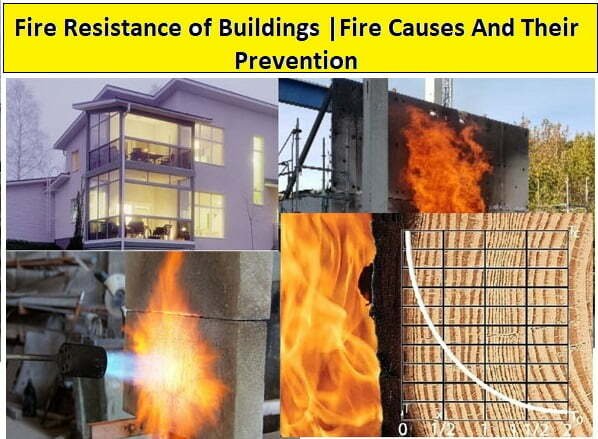Fire Resistance of Buildings |Fire Causes And Their Prevention
Buildings catch fire. Buildings can catch fire for a number of reasons. Most fires are caused by a short circuit in the power supply. Also, items lying near stoves or heaters can catch fire easily. They can also cause fires such as petrol, kerosene, etc. Sometimes careless throwing of a burning cigarette or a stick of matches on a burning object can also cause a fire. Introduction of The Fire Protection Building| Fire Resistance of Building Materials Fire Causes And Their Prevention ||Fire Resistance of Buildings.Fire Resistance of Buildings |Fire Causes And Their Prevention.
Fire Resistance of Buildings |Fire Causes And Their Prevention
Introduction of The Fire Protection Building
Buildings catch fire. Buildings can catch fire for a number of reasons. Most fires are caused by a short circuit in the power supply. Also, items lying near stoves or heaters can catch fire easily. They can also cause fires such as petrol, kerosene, etc. Sometimes careless throwing of a burning cigarette or a stick of matches on a burning object can also cause a fire. When a fire breaks out, try to put it out immediately. If the fire is not brought under control in half an hour, it becomes uncontrollable. In case of fire, the material available for burning on the spot is called fire load. Measuring units of calories is used to guess the fire load. Where there is a high risk of fire such as petrol pumps and gas stations, fire extinguishers should be kept ready at all times and staff should be trained to put out fires. If the fire cannot be contained, the fire brigade should be called immediately. Water is mostly used to extinguish fires. For this purpose, a special large-size hydrant is provided on the water supply line which is installed at the beginning of each street, in the middle, and at the appropriate places at the end.
The construction of buildings should use materials that do not catch fire easily or can retain their strength for a long time in case of fire. Brick masonry and light concrete have adequate fire resistance. If wood is to be used, it should be treated with a chemical solution such as ammonium phosphate. Steel members should be covered with fire-resistant material. Asbestos can be used for this purpose. The building should be so designed that people can get out of the building quickly in the event of a fire. Stairs and doors should be installed in large numbers for this purpose. There should also be alternative routes for firefighters to enter the building. Upon completion of the building, fire extinguishers should be installed at appropriate locations and appropriate arrangements should be made to notify firefighters.
Fire Resistance of Buildings
No building is completely safe from fire. Different materials used in building construction have different resistance against fire. In the event of a fire, some materials lose their strength immediately, while some materials last for a few hours and some for a long time. The length of time a building can last after a fire is called the Fire Resistance of the Building.

Fire Causes And Their Prevention
Whenever there is a fire in a building, the main source is a minor fire For example, a burning cigarette, a burning stick, or a small electric spark, etc. Then the fire begins to spread. The following are the sources of its spread Which are believed to be the cause of the fire in the building.
1. Items that catch fire quickly, such as gasoline, kerosene, etc. Such items should not be stored unsafely. They should be stored as much as possible in a place where there is no risk of fire and they should not be stored in the passage.
2. Items that can easily burn in the presence of oxygen, such as clothing. wooden furniture and paper, etc. If these items are close to a permanent source of fire, there is a risk of fire. ‘Heater, etc. should be kept away. 3. Do not use the overheated stove or heater for lighting fire as it can also cause fire
Fire Resistance of Building Materials
The materials used to create fire resistance while constructing any building should have the following qualities.
-
1. Materials should be such that it does not well at a high temperature and kept to a minimum
-
2. The rate of expansion and contraction due to temperature should be
-
3. After heating when it is cooled by adding water, it should not be compressed rapidly as it causes material damage.
-
4. The material used should be so strong that it cannot catch fire quickly.
There is no material in which all the above qualities are fully present.
Stone
Stone has great resistance to heat, but when thrown into the fire. fire resistance of different building materials is as follows. it breaks into pieces.
Granite,
which is a high-quality stone, that breaks down into smaller pieces when heated. While limestone heats up and becomes soft limestone. To some extent, sandstone tolerates temperature, but at higher temperatures, it breaks down.
Bricks
Bricks also offer great resistance to heat and can withstand very h temperatures up to 200 degrees Celsius in the event of a fire. ever, they break down by pouring water at higher temperatures. Bricks are considered to have better fire resistance than other materials.
Fire Bricks
These are bricks that are made especially for high temperatures. They can withstand temperatures as high as 2000 degrees Celsius. They are used in places where fires are burning all the time, such as iron-smelting furnaces and chimneys. Because the price of these bricks is much higher than ordinary bricks. Therefore, they cannot be used in ordinary buildings.
Glass
Ordinary glass cannot withstand high temperatures. The characteristic of glass is that it is cooled by adding water after heating. acks will appear in it. Certain types of glass, such as fiberglass and reinforced glass, are more fire-resistant than ordinary glass and are more tolerant of instantaneous temperature changes
Timber
Wood prevents heat from passing through but starts to burn on its own. If a solution of ammonium phosphate is applied, the wood is also protected from fire.
Cast Iron
A characteristic of cast iron is that if it is heated and cooled immediately, it breaks down, so it is not used in building construction. If it is to be used, it should be covered in brick or stone masonry.
Steel
Definition And Difference B/w Main Bar And Distribution Bar
Find The Bar Bending Schedule For Duct Bank
Steel is the best conductor of heat and heats up quickly. It heats up and softens, which causes it to lose its strength. In buildings where there is a high risk of fire, a thick layer of concrete should be used on the steel.
Concrete
Grades | Types And Process of Mixing of Concrete
Concrete does not pass heat quickly and has very high fire resistance. Concrete is considered to be the best fire-resistant building material. However, if steel bars are to be used in concrete, a thick layer of concrete should be placed it. Concrete remains strong up to a temperature of 300 degrees Celsius.
Asbestos
Asbestos is a fiber material that can withstand temperatures up to 1000 degrees Celsius. But usually, this material is used to make sheets 2.5 cm to 7.5 cm thick, which are used to make curtain walls or they can be placed on the walls to protect the building against fire.


